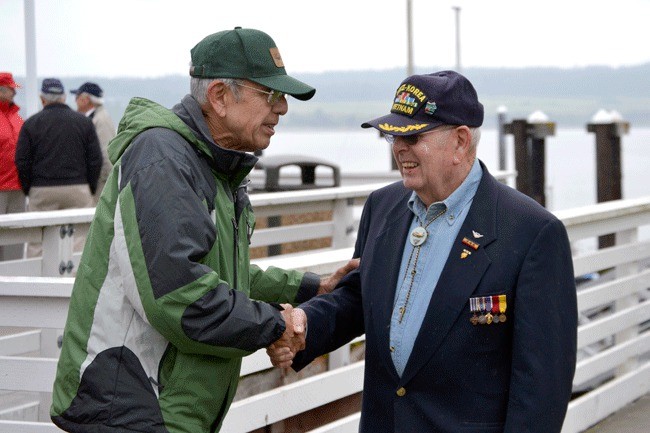There’s a difference between reading about history and making history.
Battle of Midway survivor Harry Ferrier knows about making history. The retired Navy commander also knows how to share history, as he did Monday during a commemoration ceremony for the 70th anniversary of the Battle of Midway at the marina on Naval Air Station Whidbey Island’s Seaplane Base.
The Oak Harbor resident was just 17 years old when he took part in one of the most important battles in U.S. military history. The Battle of Midway raged in the Pacific from June 4 through June 7, 1942. Outgunned and outnumbered by the Japanese Imperial Navy, American forces outsmarted and outmaneuvered the Japanese, turning the tide of victory in our favor.
“Those men and boys at Midway … did more for their country in three days than most of us do in our lifetime,” said NAS Whidbey Island commanding officer, Capt. Jay Johnston. “They had no right to win. Yet they did. And in doing so they changed the course of the war.”
Ferrier, a radioman/gunner at the time, was in one of six new TBF Avenger aircraft from Torpedo Squadron (VT) 8, assigned to Midway Atoll in the Pacific to reinforce the Marines there.
Of 51 American torpedo-carrying planes involved in the battle, only seven returned. Out of 15 TBD Devastators and six TBF Avengers from VT-8 that began the battle on June 4, only one plane — Ferrier’s — made it back.
“I was fortunate to have a wonderful pilot (Ensign Albert Ernest) who knew his plane and knew his job,” Ferrier told the crowd of active duty personnel, community leaders, students and other members of the public.
“What is always important to remember are those men who gave up their lives,” he said. “They made it possible for the dive bombers to do their jobs.”
In the end, American forces destroyed four Japanese aircraft carriers and one destroyer, and badly damaged several other Japanese ships.
“This battle changed the course of U.S. naval history,” said Johnston. “If we had not succeeded at Midway, we wouldn’t have had troops to send to Europe. D-Day might never have happened.”
A new addition to the ceremony was Oak Harbor High School junior Brittany Rigby, who was chosen to read her essay on the significance of the battle.
“After learning about the Battle of Midway, I have a whole new respect for not only the men in battle that complete their missions, but also those who weren’t able to,” read Rigby
As the numbers of WWII survivors dwindle, the importance of explaining the significance of events like the Battle of Midway to younger generations grows.
Marine PFC Maggio Hardy, 19, wasn’t familiar with the Battle of Midway. But as he shook hands with Ferrier after the ceremony, he knew he’d touched a piece of living history.
“It’s a privilege, right there,” he said.
“We’ve got to remember the battles they’ve fought,” agreed Emmett Jaime, after shaking Ferrier’s hand. “We need to remember our veterans in every possible way to show our appreciation for what they went through.”
“As difficult as that battle was,” Ferrier told the crowd, “our Navy can be proud of those who succeeded them. I’m glad I got to be here to give a little insight.”



